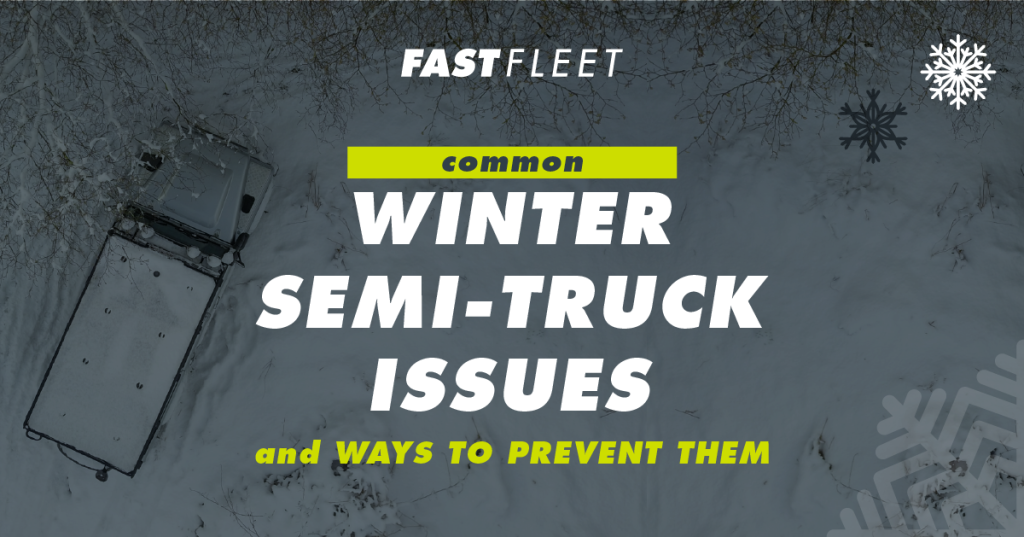Perhaps one of the most dreaded seasons for semi-truck drivers is at our doorstep. In some places, you can already hear the ice scrapers on the windshields during the early morning hours. Huge plumes of exhaust smoke overtake residential driveways as cars are started, so they can be warm before it’s time to leave for work or usher the kids to school.
For semi-truck drivers, this means taking the necessary precautions to ensure your rig continues to be as dependable as ever. Winter is tough on normal vehicles. Magnify these issues tenfold when you factor in the sheer size of all of the working components on a semi-truck.
This makes for a sizeable checklist to take down heading into the colder months. However, getting started during mid-fall can give you ample time to tackle all of your problem areas and get them winterized before the ice hits the roads.
Problem areas for semis during the winter
The job of a semi-truck driver is incredibly important, especially during the holiday season. We depend on these short and long-haul truckers to keep the supply chain moving, so we have a steady supply of items we normally take for granted.
This is why keeping a well-maintained semi-truck during the winter is vital for us as consumers and for the drivers’ safety. Winter can wreak havoc on anything with an engine, so proper maintenance on something with high usage, like a semi-truck, during the winter is crucial. Listed below are some of the primary areas of concern during the colder months.
1. The Tires
Like any other vehicle, cold temperatures can cause a substantial amount of damage to the tires of a semi-truck. Worst of all, the majority of the time, most of this damage can go unnoticed.
When a sudden drop in temperature strikes an area, air molecules begin to slow down. This slower movement of air molecules causes a drop in pressure in anything with high amounts of compressed air. Can you guess what happens next?
Slowly, the tires begin to go flat. Normally this happens gradually, which can be more detrimental for the semi-truck driver. When a tire slowly loses pressure, the tread begins to wear unevenly.
Not only does this lead to untimely wear on the tire, but it can also bring the potential for a blowout. This could be a life-threatening situation for the semi-truck driver and any vehicle within a reasonable distance. Use these steps to avoid a catastrophic blowout on the road this winter:
- Always check your tire pressure before starting a route. Every single tire should be properly inflated
- · It’s good practice to overinflate somewhat during the winter to compensate for the lost air pressure.
- As a preventative measure, you can fill your tires with extra air before shutting your truck down for the evening. This doesn’t mean you don’t have to check them the next morning, but it could save you a few extra minutes before starting your travels.
- Keep a constant check on the treads of your tire. If your treads become noticeably low, this can cause your semi-truck to lose traction and lead to sliding on the roads. Performing a normal checkup on the treads can avoid a potentially serious loss of traction on the highway.
2. Check your battery
Most vehicle owners have probably walked outside to start their car in the winter, only to find out they have a dead battery. Normally this is a minor issue for the average commuter. However, when you’re a semi-truck driver, having an unexpected dead battery can mean going without heat for hours in the middle of nowhere. This minor issue can be a potentially deadly situation.
Before you leave for a long trip, it’s not a bad idea to use a voltage meter to check that your battery is operating efficiently. Additionally, it can be a wise choice to carry an extra battery for emergencies or a battery charger if your current unit goes dead.
You can also use voltage meters to check your alternator as well. Another electrical component can be negatively affected during cold weather or when the battery has issues. These two components go hand-in-hand.
3. Check your electrical connections
While we are on the subject of batteries and electricity, sometimes it’s not the major components that bring issues. Many times, it can be the result of a faulty electrical connection. Many places use salt and other harsh materials to remove snow and ice from the roadways during the winter.
Many of these materials are highly abrasive and can lead to high levels of corrosion on different parts of your semi-truck. Have you ever seen a highly corroded battery terminal? Imagine that, but throughout every wiring system on your truck.
You could experience the following issues because of corrosion:
- Faulty headlights
- Issues with your radio
- Problems with the heat/defrost
- Connections to the reefer if your truck is refrigerated
The worst part about these corrosion issues is the fact that they can strike without warning. This means that you could be driving, and any of the following elements could fail. Because of corrosion, you could be driving with properly working headlights and lose all lighting function the next. This isn’t a problem you want to deal with while you’re driving on an already hazardous road. The following steps can help you avoid these hazards:
- Check each electrical connection on the truck.
- Most of the corrosion will be present on the harness and connection areas. Pay close attention to these areas specifically.
- Use a wire brush to clean these areas of any buildup and corrosion. Be sure not to disconnect any vital wiring while you’re performing maintenance.
4. Windshield and mirrors
This seems like a pointless area to go over, but the windshield of a semi-truck is especially important. The windshield of a big rig is a huge area, and for a good reason. Visibility is one of the most important dynamics for a semi-truck driver.
Additionally, the mirrors can be equally as important. Clear and properly functioning mirrors and windshields are sometimes the only things separating commuters from a merging semi-truck.
Give your truck plenty of time to heat up in the mornings. Make sure the defrost is engaged to properly knock the frost or freeze off of the entirety of the windshield. Use an ice scraper when temperatures become especially cold and the wipers won’t do the job.
Mirrors are huge problem areas for semi-trucks during the winter. One foggy or frozen mirror can cause a semi-truck to merge into an entire lane full of vehicles. Do a thorough once-over of your truck every morning to ensure all of the mirrors are cleared properly.
Fluctuating temperatures can also be a problem for windshields during the winter. A small crack can easily turn into a huge gash if you’re not careful. One of the most important things to remember is to try and avoid using your defrost or putting additional heat on the windshield until a minor crack is repaired. In the winter, this is almost impossible.
That’s why it’s important to get any small chips repaired immediately. Don’t ignore even the smallest imperfection, as these can turn into a huge headache if you’re not careful.
5. Fuel and Cooling systems
Cold temperatures can cause your fuel to underperform during the winter months. It’s not uncommon for semi-trucks to get substantially lower fuel efficiency on extremely cold days. This can also lead to bigger problems in the long run for your entire fuel system.
Using a high-quality additive to treat your fuel can make it burn more efficiently when it’s cold outside. These additives prevent your fuel from turning into a gel when the temperatures dip below freezing, and this can save vital components like the fuel filter and pump.
Don’t ignore the cooling system on your truck, either. The radiator and cooling components are especially fragile during the winter.
It’s important to keep a regular check on the radiator and the rest of your cooling system to ensure nothing is freezing or locking up. Watch for any leaks or signs of dripping while you’re traveling. When you stop for fuel, do a quick once-over of your truck from all angles. A quick walkaround should be sufficient to check for any signs of leaking.
Additional travel tips for semis during the winter
Checking all of the vital areas of your truck during the winter can stop you from becoming stranded when it’s cold. However, these aren’t the only precautions you should take to keep your truck going and ensure your safety.
Use the following additional tips to make sure you remain safe and protected while fulfilling your routes in the winter.
Prepare for dangerous roads and familiarize yourself
You should have a pretty good idea of what your route looks like before you start your journey. If it’s a new route for you, try to do as much research as you can before hitting the road. You need to familiarize yourself with any potential hazards you could face if the weather takes a turn for the worst. Ask yourself the following questions regarding your route:
- Are there any steep inclines or downgrades?
- Are there any steep inclines or downgrades?
- Is there any construction or other slowdowns?
- Are there any detours?
- Is the area known for bad weather?
- What are the elevations?
Knowing the answer to all of these questions can prepare you for even the worst roadways. If you can answer yes to any of the previous questions, it’s important to be prepared for the worst.
Make sure you have an emergency road kit somewhere in your truck. It’s also a good idea to bring a blanket, water, and some extra food. Roadside service and fleet management companies are usually very efficient. However, when bad weather strikes, things can become very unpredictable.
You should pack all of the following items:
- A shovel
- Flares
- Flashlights
- Batteries
- Extra fluids for your vehicle
Pay attention to the weather
It’s important to pay attention to the weather at all times when cold conditions can cause hazardous driving conditions. It’s even more important when you drive a semi-truck.
It only takes a few minutes every day to catch the latest forecast along your route. However, it’s important to keep in mind that some areas along your route could be prone to fast-changing conditions. This is especially true in areas of higher elevation.
It’s not a bad idea to have some sort of weather alert system set up for your in-cab GPS or an alert system on your phone. These alert systems can keep you updated in the event of quickly changing or developing weather systems.
In some areas of the Midwest, it’s not uncommon for whole stretches of the interstate to get shut down because of snowdrifts and freezing conditions. Weather alerts can notify you during times where it might be necessary to take an alternate route.
Driving a semi-truck during the winter can be a very hazardous way to make a living. At the very least, it can be incredibly unnerving.
Rapidly deteriorating conditions, combined with the responsibility of towing thousands of pounds of cargo, can place a truck driver in some less than undesirable conditions. However, this is when it becomes important to remain calm and exercise your training and skills.
Driving a semi-truck during the winter doesn’t have to be a nightmare with a fair combination of driving expertise and early preparation. Make sure you use a checklist, keep your vital components well-maintained, and pack the essential items for an emergency.
It’s also important to have a quality fleet management and maintenance service on deck at all times. Fast Fleet Services can help you prepare and keep your fleet well-maintained for winter driving. Don’t hesitate to contact us with any questions you have about our services!
















